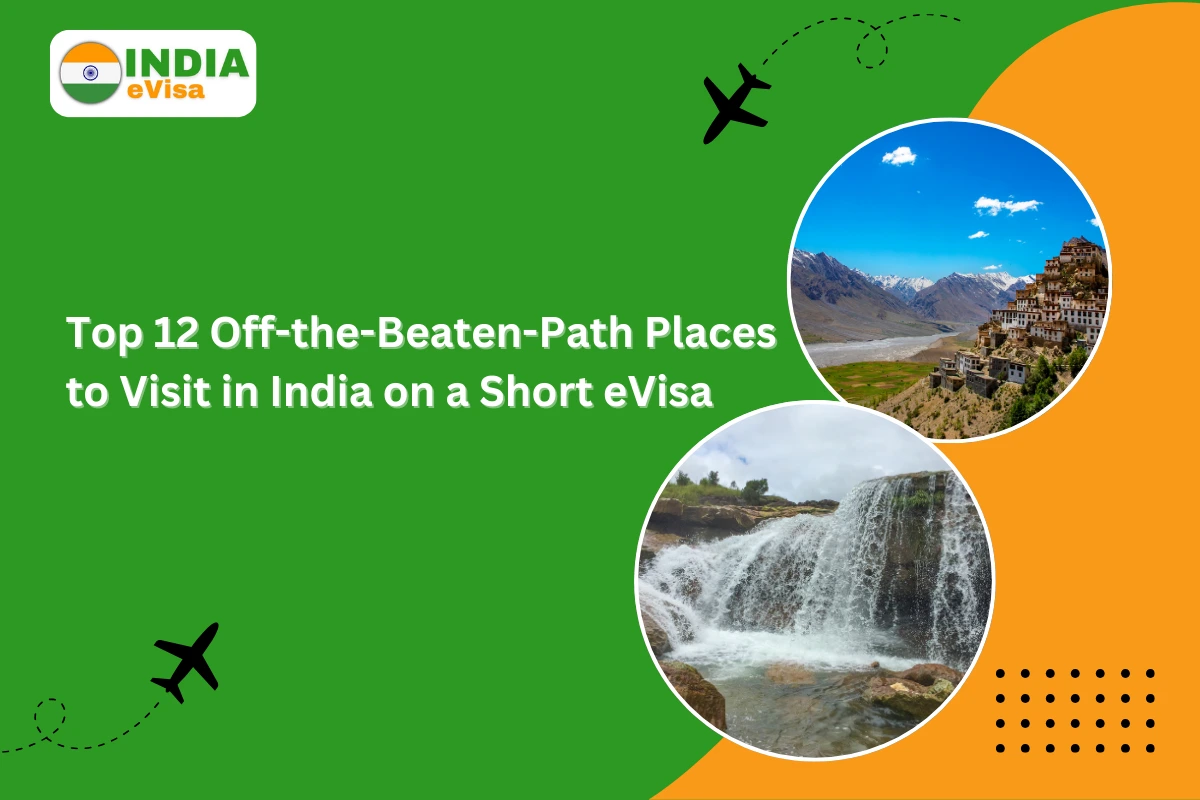Top 12 Off-the-Beaten-Path Places to Visit in India on a Short eVisa

India has so much to offer beyond crowded hotspots. If you have a short eVisa and want calm, culture, and real local life, this list of Places to Visit in India will help you pick smartly. I’ve written this in simple English and shared clear travel and paperwork tips so you won’t be left with questions. Before you travel, apply through India Visa Online and check your India Visa Status to be sure everything is in order.
1. Spiti Valley (Himachal Pradesh)
Why go: Raw mountain views, small Buddhist villages and clear night skies make Spiti a quiet escape.
How to go: Fly to Kullu or Chandigarh and drive in; many travelers take the road from Manali or Shimla. Best time: May–September. Spiti feels like another world and is perfect for nature lovers.
2. Ziro Valley (Arunachal Pradesh)
Why go: Green rice terraces, friendly Apatani villages, and a calm pace. Ziro is small, lovely and restful.
How to go: Fly to Lilabari or Tezpur, then drive. Best time: March–October. Note: Arunachal has special permit rules — foreign visitors usually need a Protected Area Permit (PAP) or Inner Line Permit (ILP). Arrange permits before travel along with your India Visa Online application if required.
3. Majuli (Assam)
Why go: The world’s largest river island on the Brahmaputra — culture, satras (monasteries), birdwatching and slow life.
How to go: Reach Jorhat, then take the ferry to Majuli (ferries run mainly in daytime; check times before you go). Best time: November–April. Ferries can be limited, so plan around ferry schedules to make the most of short visits.
4. Gokarna (Karnataka)
Why go: Quiet beaches, easy walks between coves, and small seaside cafes — a peaceful beach break without busy crowds.
How to go: Train or drive to Gokarna; beaches like Kudle and Om are walkable from town. Best time: October–March.
5. Hampi (Karnataka)
Why go: Huge, fascinating stone ruins and boulder landscapes. Hampi feels timeless and is compact enough for a short stay.
How to go: Fly to Hubli or take a train to Hospet, then short drive. Best time: October–February. Hampi is a UNESCO-protected site and is very visitor-friendly for short trips.
6. Chandra Taal (Himachal Pradesh)
Why go: A high-altitude glacial lake with peaceful camps and bright stars. Best for campers and small-group trips.
How to go: Drive toward Batal/Manali area, then trek or use seasonal roads. Best time: June–September.
7. Dzukou Valley (Nagaland / Manipur border)
Why go: A hidden valley with grassy meadows and seasonal flowers — ideal for a short, gentle trek and quiet camping.
How to go: Reach Kohima or Imphal and join a local trek. Best time: October–May. Note: parts of the northeast may need permits — check rules early.
8. Tawang (Arunachal Pradesh)
Why go: A beautiful, high Himalayan town with a famous monastery and peaceful mountain views.
How to go: Long scenic drive from Tezpur or Guwahati. Best time: Late spring to autumn. Tawang also falls under PAP/ILP rules, so book permits early.
9. Lakshadweep (if you can extend a little)
Why go: Crystal water, coral islands and calm island life — perfect for snorkeling and rest.
How to go: Fly or ship from Kochi. Best time: October–March. Important: Lakshadweep requires an entry permit for visitors — get this before you travel and confirm your India Visa Status and passport details as part of the permit process.
10. Chettinad (Tamil Nadu)
Why go: Old mansions, spicy local food and unique architecture — a quiet cultural stop in the south.
How to go: Fly to Madurai or Trichy, then drive. Best time: October–March.
11. Kinnaur (Himachal Pradesh) — villages like Nako
Why go: Small mountain villages, apple orchards, and dramatic river valleys. A gentle, authentic Himalayan visit.
How to go: Drive from Shimla or Chandigarh. Best time: May–October.
12. Rann of Kutch (Gujarat)
Why go: Wide white salt flats, remote villages and surreal moonlit nights — especially peaceful outside festival times.
How to go: Fly to Bhuj and drive in. Best time: November–February.
Practical tips you must know
- Always apply through the official India Visa Online portal and print or save your approval. Then double-check your India Visa Status before travel. This avoids last-minute surprises.
- For the northeast and some islands, you will need special permits (ILP or PAP). These are separate from your eVisa and take time — get them early.
- If your eVisa is short, choose one or two Places to Visit in India in the same region. Travel time between distant spots wastes your visit.
- For high-altitude spots (Spiti, Chandra Taal, Tawang), carry warm layers and allow time to adjust. For river islands (Majuli), bring insect repellent and light rain gear.
- Stay in local guesthouses or homestays. They are friendly, affordable, and make your trip feel human and real.
Final thoughts
These quiet Places to Visit in India give you calm, culture and memories — exactly what many travelers want on a short eVisa. Before you leave, confirm your India Visa Status and any local permits, pack sensibly, and choose a small region to explore slowly. If you want, I can turn this into a ready-to-publish blog with headings, images and internal links to your “Apply” and “Check eVisa Status” pages.
